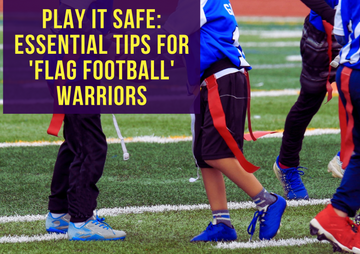Play It Safe: Essential Tips for 'Flag Football' Warriors
Welcome to the thrilling world of flag football, where the game is fast, fun, and full of excitement! Whether you're a seasoned player or a flag football rookie, ensuring a safe experience on the field is crucial.
In this blog, we'll dive into the top safety tips and injury prevention techniques to keep your flag football games enjoyable and injury-free.
Warm-Up Wonders:
Before diving into the action, it's essential to prep those muscles and joints.
A proper warm-up not only prevents injuries but also enhances your performance on the field. Include dynamic stretches, light jogging, and agility drills to get your body ready for the dynamic movements ahead.
Remember, a well-warmed body is a resilient one!
Warm Ups for Flag Football:
a. Dynamic Stretching Routine: Before the game kicks off, engage in dynamic stretches such as high knees, leg swings, and arm circles. These movements increase blood flow to your muscles and improve flexibility, priming your body for action.
b. Agility Cone Drills: Set up agility cones and weave through them, incorporating lateral movements and quick direction changes. This not only warms up your muscles but also enhances your agility on the field.
c. Shuttle Runs: Performing shuttle runs at varying speeds helps elevate your heart rate and prepares your body for the bursts of sprinting and lateral movements required in flag football.
d. Jumping Jacks and Burpees: These classic exercises are excellent for elevating your heart rate, warming up your entire body, and getting you mentally prepared for the game ahead.
e. Team-Based Warm-Up Drills: Incorporate team-based drills like passing the ball in a circle or performing synchronized movements. This not only warms up individual players but fosters teamwork and camaraderie.
Gear Up for Safety:
Flag Football Safety Gear and Equipment:
a. Flag Belts: Invest in high-quality flag belts that securely hold the flags but also detach easily during gameplay. Check for any signs of wear and tear regularly.
b. Cleats: Choose cleats with good traction to prevent slipping on the field. Ensure they fit well to avoid discomfort and reduce the risk of foot injuries.
c. Mouthguards: Protect your teeth and jaw with a properly fitted mouthguard. Even in non-contact sports like flag football, accidental collisions can happen.
d. Eye Protection: Consider wearing protective eyewear, especially if you wear prescription glasses. This safeguards your eyes from potential pokes or injuries during the game.
e. Comfortable Apparel: Wear comfortable, breathable clothing that allows for a full range of motion. Avoid clothing with hanging accessories that could be grabbed during the game.
Injury Prevention Exercises:
Let's tackle the issue of injuries head-on with targeted exercises. Strengthening the core, improving flexibility, and focusing on lower body stability are key components of injury prevention.
Incorporate exercises like squats, lunges, and agility ladder drills into your training routine to build a resilient and injury-resistant body.
Injury Prevention Exercises:
a. Core Strengthening: A strong core enhances overall stability and reduces the risk of injuries. Include exercises like planks, Russian twists, and bicycle crunches in your routine.
b. Balance and Stability Drills: Improve your balance through exercises like single-leg stands and stability ball exercises. Better balance reduces the likelihood of ankle and knee injuries.
c. Lower Body Strengthening: Target your lower body muscles with exercises like squats and lunges. Strengthening these muscle groups provides better support during quick movements and sudden changes in direction.
d. Flexibility Training: Dynamic stretches and yoga poses enhance flexibility, allowing your body to move more freely and reducing the risk of strains and pulls.
e. Proper Cool Down: Include a proper cool-down routine with static stretches targeting major muscle groups. This helps prevent muscle tightness and promotes faster recovery.
By incorporating these warm-ups, safety gear, and injury prevention exercises into your flag football routine, you're not just playing the game; you're taking proactive steps to ensure a safe and enjoyable experience on the field.
Listen to Your Body:
In the heat of the game, it's easy to ignore those little signals your body sends. Whether it's a twinge in the knee or a hint of fatigue, listen to your body.
Take breaks when needed, stay hydrated, and don't push yourself beyond your limits. It's not just about winning; it's about enjoying the game for the long run.
Fair Play Guidelines:
Safety isn't just about physical well-being; it's also about creating a respectful and inclusive environment on the field.
Embrace fair play principles, emphasizing good sportsmanship, respect for opponents, and adherence to the rules. Check this out!
A friendly game is a safe game!
Stay Informed:
Flag football rules and safety guidelines may evolve, so stay informed.
Attend workshops, read updates, and familiarize yourself with the latest recommendations for safe flag football play.
Knowledge is your best defense against injuries.
Frequently Asked Questions about Flag Football Safety:
Is flag football safe for all age groups?
Yes, flag football is generally considered safe for all age groups. It's a non-contact sport that minimizes the risk of injuries associated with traditional football. However, proper safety measures, including equipment and warm-ups, should be observed.
Are there specific warm-up exercises recommended for flag football?
Yes, warming up before a flag football game is crucial. Dynamic stretches, agility cone drills, shuttle runs, and team-based warm-up drills are excellent choices to prepare your body for the physical demands of the game.
What safety gear is essential for flag football players?
Essential safety gear includes flag belts, cleats with good traction, mouthguards, eye protection if necessary, and comfortable, breathable apparel.
Choosing the right gear contributes significantly to injury prevention.
Are there injury prevention exercises specific to flag football?
Absolutely. Core strengthening exercises like planks, balance and stability drills, lower body strengthening with squats and lunges, flexibility training through dynamic stretches, and a proper cool-down routine are essential for injury prevention.
How often should safety gear be inspected for wear and tear?
Safety gear, especially flag belts, should be inspected regularly, preferably before each game or practice. Look for signs of wear and tear, such as frayed straps or weakened attachments, and replace any damaged equipment promptly to ensure optimal safety.
Conclusion:
Flag football is more than a game; it's an exhilarating experience that brings people together.
By prioritizing safety through proper warm-ups, quality gear, injury prevention exercises, fair play, and self-awareness, you're not just playing the game – you're ensuring a fun and injury-free journey on the field.
So, gear up, follow these tips, and let the flag football fun begin!
Check Out Our Previous Articles!
Flag Football: A Safe and Exciting Alternative to Tackle Football
Why Is Flag Football Beneficial to your Health?
How Playing Flag Football Helps You Burn Calories
Start 'Flag Football' Easily This Season – Ready to Join In?















